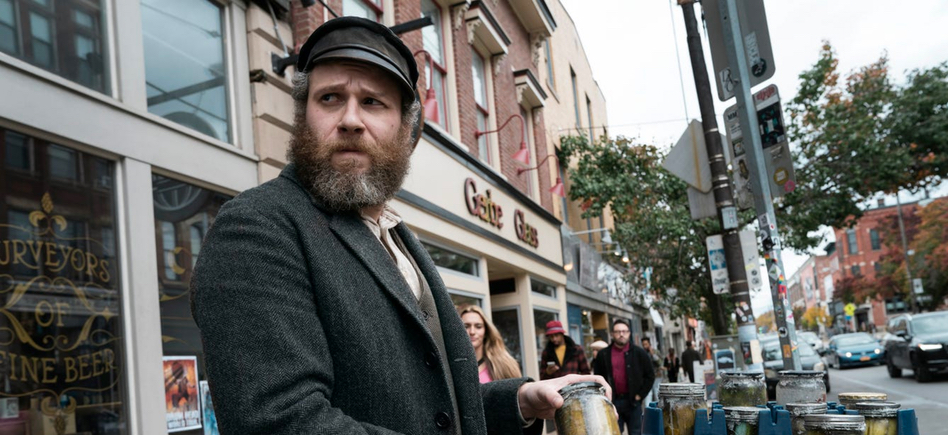AN AMERICAN PICKLE
HBO Max
Reviewed for Shockya.com & BigAppleReviews.net linked from Rotten Tomatoes by: Harvey Karten
Director: Brandon Trost
Screenwriter: Simon Rich adapted from his novella “Sell Out” in New Yorker Magazine
Cast: Seth Rogen, Sarah Snook, Sean Whalen, Jorma Taccone, Joanna Adler, Jeff Daniel Phillips, David Mattey
Screened at: Critics’ link, NYC, 7/30/20
Opens: August 6, 2020
Rip van Winkel fell asleep in the borscht belt and woke up twenty years later. Or so he thought. “Fiddler on the Roof” focuses on the Jewish community in 19th Century Eastern Europe, its residents always watching out for the Cossacks. In the movie “Borat,” the title character, Borat Sagiyev, wanders to the U.S. from the Kazakh backwaters to interview people in the modern U.S. In David Mamet’s “Homicide” (1991), Bobby Gold (Joe Mantegna), a police detective investigating a murder that takes place within an Orthodox Jewish community, is criticized by a Hasidic Jew for being secular, the latter wondering whether there is anything spiritually real in a cop who does not embrace his religion. All of these and more are channeled in “An American Pickle,” directed by Brandon Trost in his freshman offering and written by Simon Rich, based on the writer’s novella “Sell Out” which appeared in New Yorker magazine January 28, 2013. By the very title of this HBO Max production, you’d figure that it would be a comedy since, after all, isn’t Seth Rogen, veteran of “The End,” “Super Bad,” “Sausage Party” and “Sorority Rising,” one of the great comic artists in the movies today?
Truth to tell, “An American Pickle,” which bills itself as a comedy-drama, or dramady, is sadly unfunny and its lesson on the importance of religion and family is generally superficial. The one big plus is that it takes place not only in Eastern Europe but mostly in my home town, Brooklyn. Oh but wait. It was filmed in Pittsburgh.
Let’s look at an example of Simon Rich’s original novella in the New Yorker.
One day at work I fall into brine and they close the lid above me by mistake. Much time passes; it feels like long sleep. When the lid is finally opened, everybody is dressed strange, in colorful, shiny clothes. I do not recognize them. They tell me they are “conceptual artists” and are “reclaiming the abandoned pickle factory for a performance space.” I realize something bad has happened in Brooklyn. The science men come and explain. I have been preserved in brine a hundred years and have not aged one day. They describe to me the reason (how this chemical mixed with that chemical, and so on and so on) but I am not paying attention. All I can think of is my beautiful Sarah. Years have passed and she is surely gone.
The initial twenty minutes or so takes place in Eastern Europe in 1820 when Herschel Greenbaum (Seth Rogen) courts and weds Sarah (Sarah Snook), supporting his new family with a job in a pickle factory. Assigned to swatting innumerable rats who begin to attack him, he falls into a barrel of pickles just as the factory is closing down for good. The lid is placed on the barrel, and the factory is unoccupied until Herschel wakes up one hundred years later, preserved in brine so that he has aged not at all. He goes to America where he learns of a relative, Ben Greenbaum (Seth Rogen in his second role!), who has been working on providing a logo for a website called Boop Bop. With a full beard and an Eastern Europe hat, Herschel quickly learns the meaning of “logo,” and is of course astonished by what he sees in Brooklyn and Manhattan—just as you and I would be if we woke up in one hundred years to observe people wearing strange outfits and speaking Esperanto.
He works at what he knows, selling pickles, obtaining cucumbers from a dumpster and sinking them in rain water and salt. At first he is a success covered by TV but has a falling out from his envious brother who retaliates against Herschel for involving him in criminal activities—seemingly ending Ben’s career.
The virtues of national attention through TV interviews and features in lecture halls appear to propel the man onward and upward but he makes one mistake, and it’s a mistake that makes me worry about how the Christians in the audience for this movie will react. I’m all for free speech, but even the First Amendment (like the Second) has its limits. What Herschel states in answer to a question about Jesus and Mary is so despicable that it has no place in such a film. Couldn’t the producers have found some other screw-ups if they wanted to show the evanescence of fame? We get enough racist crap and Islamophobia weekly from Donald Trump. There’s no need for disparagement of a religion with billions of followers. Sure it’s OK to kid as does the movie “I, Pastafari” (a bizarre group of people follow a religion whose god is a flying spaghetti monster) which opened July 7th and has all of eight reviews on Rotten Tomatoes. But this is going too far.
Ultimately, the picture turns sentimental, when the brothers reunite after their schism, announcing that family is important, and (according to this picture) so is religious ritual. But there is not much in the way of either comedy or drama, though the visuals—which allow Seth Rogen to play both roles, even to hug each other seamlessly—are awesome.
90 minutes. © 2020 by Harvey Karten, Member, New York Film Critics Online
Story – C-
Acting – B
Technical – B+
Overall – C+

